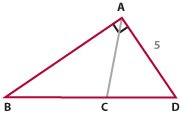chiragatara wrote:
If angle BAD is a right angle, what is the length of side BD?
(1) AC is perpendicular to BD
(2) BC = CD
Official answer explanation:
Using statements 1 and 2, we know that AC is the perpendicular bisector of BD. This means that triangle BAD is an isosceles triangle so side AB must have a length of 5 (the same length as side AD). We also know that angle BAD is a right angle, so side BD is the hypotenuse of right isosceles triangle BAD. If each leg of the triangle is 5, the hypotenuse (using the Pythagorean theorem) must be 5 underroot 2.
Can someone kindly explainthe underlined portion?
For such kind of graphic questions you MUST post the image. Next, please also do check the OA's when posting a question, OA for this one is C, not E.
Original question is below:
If angle BAD is a right angle, what is the length of side BD?
(1) AC is perpendicular to BD
(2) BC = CD
Now, obviously each statement alone is not sufficient.
When taken together we have that AC is a perpendicular bisector. Now, if a line from a vertex to the opposite side is both perpendicular to it and bisects it then this side is a base of an isosceles triangle (or in other words if a bisector and perpendicular coincide then we have an isosceles triangle). You can check this yourself: in triangles ACD and ACB two sides are equal (AC=AC and BC=CD) and included angle between these sides are also equal (<ACD=<ACB=90) so we have Side-Angle-Side case (SAS), which means that ACD and ACB are congruent triangles, so AB=AD --> ABD is an isosceles triangle.
Next, as ABD is an isosceles triangle then AB=AD=5 and hypotenuse \(BD=5\sqrt{2}\).
Answer: C.
For more on this Triangles chapter of Math Book:
https://gmatclub.com/forum/math-triangles-87197.htmlHope it helps.
Attachment:
triangleABCD.jpg
If the bisector of an angle in a triangle meets the opposite side at its midpoint, then the triangle is isosceles.?
is this correct .
or the bisector must meet the opposite side at mid point and at 90 degrees ( i.e. teh angle bisector line should be perp bisector of opposue side)





